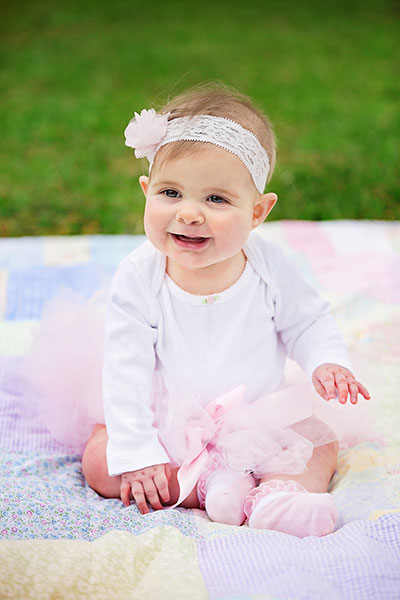
As Kenzie and Ricky attended their routine 18-week ultrasound, they expected everything to go smoothly; however, they received unexpected information about their baby girl, Macy. Their unborn daughter was diagnosed with a unilateral cleft (a split occurring on one side) that extended all the way back from her lip to her palate.
Kenzie and Ricky started learning everything they could about cleft-affected children and began looking for the right medical team to help them. "The interdisciplinary cleft team affiliated with Children’s Memorial Hermann Hospital and McGovern Medical School at UTHealth was the right fit – particularly the combination of extensive experience and an approach to treatment that included fewer surgeries than they had previously been counseled would be necessary," Kenzie says.
“The surprise was hard to deal with and it took a couple of weeks to adjust,” Kenzie says. She worried, “How will she feed? Will she struggle with speech? Will she be teased?”
Prior to the delivery, Macy’s parents met with Matthew Greives, MD, board-certified affiliated plastic surgeon and fellowship-trained specialist in Craniofacial and Pediatric Plastic Surgery, who is part of the Texas Cleft-Craniofacial Team and Director of the Vascular Anomalies Clinic at McGovern Medical School. He carefully walked them through what they might expect.
“A cleft seems like a catastrophic diagnosis,” Greives says, “but it helps when parents are prepared. Macy’s parents were very involved from the beginning - researching, asking questions, and by the time she was born, they were nearly experts.”
Clefts manifest themselves in several different ways, and each type may range from relatively minor to extensive. They may be unilateral – on one side of the face, as in Macy’s case, or bilateral – on both sides. Either type may affect the lip, or the palate, or both. Clefts, one of the most common birth defects, occur in approximately one in 1,000 babies in the U.S.
Dr. Greives worked with the family to explain that each baby has an individualized treatment plan that depends on the location and extent of the cleft, but the process follows a pattern, which he explained in detail in a highly informative patient webinar.
Typically a child’s treatment plan includes:
- Two weeks after delivery: Baby undergoes initial assessment and a preliminary treatment plan is developed with the family
- 3-6 months: Lip repair
- 1 year: Palate repair and insertion of ear tubes to aid fluid drainage also, assessment and start of speech therapy
- 7-9 years: Alveolar bone graft, which utilizes bone taken from the hip to repair the bony cleft in the child's gum ridge, followed by braces to straighten teeth
- 17-18 years (after growth is completed): Jaw realignment and rhinoplasty

As Kenzie and Ricky prepared for their daughter’s birth, they were connected with other cleft families in the Houston-area and were opened up to an invaluable network of families who could relate to their process and concerns. Dr. Greives says the Houston-area community of cleft families is an invaluable asset to parents, offering blogs, Facebook groups, peer counseling and good old-fashioned moral support. These groups provide parents reassurance that their child is not the only child affected with a cleft and offers support in many ways – pre/post surgeries, opinions regarding treatments, or even random questions relating to everyday life. Kenzie certainly found that to be true. Before Macy’s birth, she walked in the Cleft Smiles 5K, a family fun event aimed to raise money and awareness for Cleft related birth defects, where she connected with other mothers who shared her concerns. From them she learned that cleft babies, in many ways, are “typical children” who are strong, resilient and happy in spite of – and perhaps because of – their condition, she says.
Macy was born on May 4, 2015. “The second I held her, I thought she was perfect. I instantly fell in love with her smile,” says Kenzie.
Macy’s first hurdle was learning to feed. After six days in the Neonatal Intensive Care Unit (NICU), she mastered how to eat from the type of bottle developed especially for cleft babies, and was discharged home. Babies with a cleft lip and palate are unable to create the suction necessary for traditional breast- or bottle-feeding.
At two weeks, it was time for the next step. A pediatric dentist with UTHealth Pediatric Dentistry, Dr. Bhavini Acharya, DDS created a nasoalveolar molding (NAM) – an appliance similar to an orthodontic retainer. Daily for 11 weeks, the NAM, which includes a stent for the nose, was inserted and taped into place at home. During weekly visits, the dentist adjusted the NAM, which gently realigns and closes the gap of the palate and lip, and shapes the nose into a normal position before surgery to repair the cleft.
Dr. Greives and Kenzie agree: the NAM is critical to successful repair, but it’s not easy. “Maintaining the NAM is a big challenge for parents,” Greives admits. Kenzie confirms that from firsthand experience. “We probably changed the tape 200 times during the 11 weeks. It was especially hard when it made her cry, but we knew it was necessary.”
Macy has now completed her lip and palate repair surgeries at Children’s Memorial Hermann Hospital. Before the first procedure, Kenzie and Ricky met with a Child Life specialist, who gave them a tour of the hospital and talked them through the process. “Our experience at Children’s Memorial Hermann Hospital – the doctors, the nurses, and the whole team – was great,” Kenzie says.
Now the family awaits the next step: Macy’s speech therapy assessment. “Right now,” Kenzie says, “there’s some speech delay and she’s pretty quiet. We’ll find out soon what she needs and get started.”
“She is the light of our lives and brings tremendous joy to our family. She was beautiful on the day she was born, on the day she received her second smile, and she is beautiful today.”
During Macy’s first year, Kenzie is helping other mothers come to the same peace and understanding she reached with the help of family, friends and other parents. “I want families to know that there is much more love and acceptance than they could ever imagine. That their family and friends will rally around them and that there's an entire community of cleft families who will welcome them with open arms and support. I'll tell them that their baby is perfect, because cleft babies redefine perfection.”